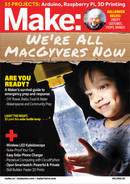
configurations. But my favorite is SparkFun
#16835, a 10W 5V panel with a built-in USB port
(Figure
H
on the previous page
). There are also
some great flexible panel options if you want
to make a wearable that is solar powered.
In addition to the solar panel specs, it’s a
good idea to keep an eye on the connectors it
comes with: either barrel jack, JST, or USB,
depending on your use. There’s nothing worse
than getting all the parts for a project and
winding up with the wrong connectors.
If you’re looking for something smaller, I also
love Osram’stiny, /" BPW-34 through-holesolar
cells (Solarbotics #SCPD, Figure
I
), 0.5V at
1.9mA, which isn’t enough to do much, but you
can chain them together in any configuration.
The Anysolar KXOB25-14X1F-TB offers 0.55V
at 55mA, but in an even tinier surface mount
package (Figure
J
); Digi-Key stocks it.
After you’ve chosen a panel, you’ll want
to pick a battery and a controller board. My
favorite is the SparkFun Sunny Buddy solar
charging board, #12885 (Figure
K
). You can
connect a single LiPo cell or similar battery
that meets your specs to the board, and the
panel will charge the battery while the battery
runs your circuit. Adafruit has a very similar
DC solar charging circuit as well, #390.
If your battery outputs 3.7V but you want
to build something like a solar-powered
Raspberry Pi which requires 5V, you may want
to use one of Adafruit’s PowerBoost boards,
#1903, to power your project (Figure
L
).
I
J
OSRAM, Anysolar, Lee Wilkins
K
L
PROJECTS: Squishy Tech
78 makezine.com
M82_074-80_SquishyTech_Lee_F1.indd 78M82_074-80_SquishyTech_Lee_F1.indd 78 7/12/22 10:45 AM7/12/22 10:45 AM
..................Content has been hidden....................
You can't read the all page of ebook, please click here login for view all page.
